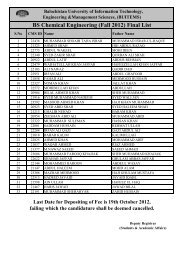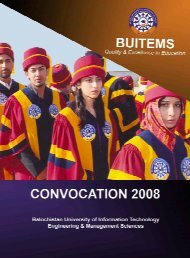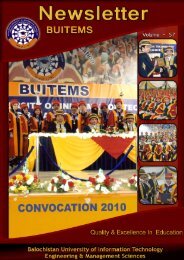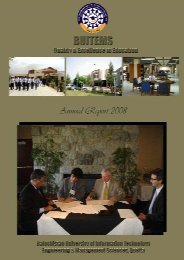BUITEMS
Research Journal - buitems
Research Journal - buitems
- No tags were found...
You also want an ePaper? Increase the reach of your titles
YUMPU automatically turns print PDFs into web optimized ePapers that Google loves.
<strong>BUITEMS</strong><br />
Quality & Excellence in Education<br />
Flow Dynamics of Two Phase (air and water ) Stratified Flow by a Simulation Package COMSOL MULTIPHYSICS<br />
(Wongwises and kalinithenko, 2002).<br />
The Simulation package Comsol<br />
Multiphysics with its built-in levelset<br />
approach is used here to simulate the<br />
two phase (air-water) flow between two<br />
plane transiently. The results may be<br />
applied to different two fluid flow problems,<br />
especially Oil-Gas (Moguedet et al., 2005).<br />
2d Models Prepared in Comsol<br />
Multyphysics<br />
The simulation is carried out in a<br />
commercial CFD (Computational Fluid<br />
Dynamics) based simulation package<br />
Comsol Multiphysics version 3.4.<br />
Since, two phase (air-water) stratified flow<br />
is understudy, there for the level set<br />
approach is used in particular, tracking<br />
the moving interface.<br />
An Overview of the Level Set Approach<br />
A large number of fluid flow problems involve<br />
moving interfaces, like air-water, breaking<br />
surface waves, combustion and reacting<br />
flows etc. The interplay between the interface<br />
dynamics and the surrounding fluid motions<br />
is of great consideration in such many<br />
applications. Factors such as density ratios<br />
and temperature jumps across the interface,<br />
surface tension effects, topological<br />
connectivity and boundary conditions play<br />
significant roles in the dynamics (Berthelsen<br />
and Ytrehus, 2005).<br />
To tackle some of the most complex<br />
problems in fluid interface, a class of<br />
numerical techniques have been built over<br />
the past several years. Relying on an implicit<br />
representation of the interface whose<br />
equation of motion is numerically<br />
approximated using schemes built from those<br />
for hyperbolic conservation laws, Osher and<br />
Sethian Level Set methods which are the<br />
computational techniques for tracking moving<br />
interfaces. The resulting techniques are able<br />
to handle problems in which the speed of the<br />
evolving interface may sensitively depend on<br />
local properties such as curvature and normal<br />
direction, as well as complex physics of the<br />
front and internal jump and boundary<br />
conditions determined by the interface<br />
location. In particular, Level Set methods are<br />
designed for problems in multiple space<br />
dimension in which the topology of the<br />
evolving interface changes during the course<br />
of events and problems in which sharp<br />
corners ad cusps are present (Rune, 2007).<br />
Governing Equations<br />
To simulate numerically the model a level set<br />
approach is coupled to the classical Navier-<br />
Stokes equations. Actually this method is<br />
very well studied to describe the motion of<br />
interface.<br />
5.1<br />
5.2<br />
5.3<br />
Where in equation 5.1,<br />
ρ is the density<br />
η is the dynamic viscosity<br />
g is the gravity constant<br />
σ is the surface tension coefficient<br />
κ = .n the curvature of the fluid<br />
interface<br />
δ is the delta function concentrated<br />
at the interface between the fluids<br />
u is the velocity field<br />
p is the pressure<br />
The term σκδn defines the surface tension<br />
forces.<br />
In equation 5.2, Ф represents the level set<br />
function and in this approach Ф at a point is<br />
the distance from the interface, such that an<br />
interface corresponds to a surface where Ф<br />
= 0. γ and ε are the level set parameters<br />
where γ is the reinitialization parameter and<br />
ε is the parameter controlling the interface<br />
thickness.<br />
Moving Air and Water Concurrently<br />
between Two Interface<br />
Air and water both are flowing co currently<br />
between two planes from left to the right. The<br />
interface and exit positions of the two fluids<br />
are not the same. The configuration consists<br />
of two sections (subdomains) water and air.<br />
The air (upper) section is a bit ahead of the<br />
88
















